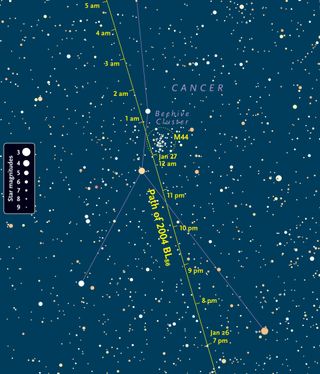Mountain-Size Asteroid Flies By Earth Today: Watch It Online

A huge asteroid will become the largest space rock of its kind to pass closest to Earth until 2027 today (Jan. 26) when it zooms safely by Earth beyond the orbit of the moon. You can see the space rock's flyby live online.
The mountain-size asteroid 2004 BL86 will star in a live webcast at 11 a.m. EST (1600 GMT) by the online Slooh observatory and may even be visible to observers with binoculars or a small telescope because of its significant size – about a third of a mile wide. At its closest approach, the asteroid will be about 745,000 miles (1.2 million kilometers) from Earth and poses no danger of hitting our planet, according to NASA scientists.
The Slooh webcast will be available free on Slooh.com. It will feature live commentary from NASA near-Earth object expert Paul Chodas and NASA research scientist Lance Benner, and be hosted by Will Gater and Slooh astronomer Bob Berman. You can also watch the asteroid 2004 BL86 flyby on Space.com, courtesy of Slooh. [Photos: Potentially Dangerous Asteroids]
"We have some really heavy hitters with this," Berman said, referencing special guest Paul Chodas, manager of JPL's Near-Earth Object Program Office. "I'm really proud of this one. This is going to be a show where you get it from the horse's mouth."
At 2:30 p.m. EST (1930 GMT), the Italy-based Virtual Telescope Project will offer a second webcast of the asteroid at: http://www.virtualtelescope.eu/webtv/.
Asteroid 2004 BL86: How to see it
At its peak brightness, the asteroid 2004 BL86 is expected to reach magnitude +9, which is a little dimmer than the planet Neptune and much brighter than the dwarf planet Pluto. This means that the asteroid will not be visible to the naked eye, but is definitely within reach to observers with binoculars or a small 3- or 4-inch telescope who know when and where to look, according to skywatching alert from Sky & Telescope Magazine.
"I think it's exciting just to look in the right direction, to stare up above where Jupiter is and say 'wow,'" Berman said.
Get the Space.com Newsletter
Breaking space news, the latest updates on rocket launches, skywatching events and more!
Observers in the Americas, Europe, and Africa will have the best seats during the asteroid's peak brightness, which will occur tonight from 8 p.m. EST until about 1 a.m. EST on Tuesday (0100 to 0600 GMT). The moon will be shining through the night, but it will be in the western sky, so its moonlight should not pose too much of an interference. [Asteroid Quiz: The Space Rock Challenge]

The asteroid will be zooming along at roughly 2.5 degrees (five times the size of the moon) per hour. Weather permitting, you should be able to see it inching its way across the sky, especially if there's a nearby star to serve as a reference point.
"Realistically speaking it's only a third of a mile, and the moon by comparison, is 2,160 miles wide," Berman told Space.com "So you figure this is one 6,000th the diameter of the moon. Plus it's three times further away. So if you put those together it'll appear 18,000 times smaller than the moon. So that means it's a dot through any telescope."
An asteroid dot in the sky
A detailed star chart provided by Sky & Telescope shows that asteroid 2004 BL86 will appear to travel northward across the constellation Cancer throughout the evening.
"For people who want to look in the right direction you just have to find the brightest 'star' in the sky … and that's Jupiter," Berman said. Then, he added, locate the star Procyon, which forms the winter triangle along with Betelgeuse and Sirius. The asteroid will be passing directly between the two stars for most of the evening.
If you look for it around midnight, however, it might be disguised as a member of the Beehive cluster. But thanks to its speedy route, it will leave the cluster around 12:30 a.m. EST (0530 GMT).
A near-Earth asteroid
The asteroid's closest approach will actually be earlier in the day, around 11 a.m. EST. But at the time it's predicted to be dimmer, at +10 magnitude, because Earth will only see a portion of its illuminated side. So once the asteroid has passed us, more of it will be illuminated, making it brighter despite the fact that it’s further away.
If you'd still like to see it at closest approach (or if you simply don't want to stand out in the freezing cold searching for the smallest of dots in the sky), you can watch it live via the online Slooh observatory, as it broadcasts the event from telescopes situated in Australia.
"We actually have a partnership going with NASA, the Asteroid Challenge, where we're working together to stimulate the amateur astronomer community to look at asteroids and provide data to the Minor Planet Center to better constrain their orbits,” said Slooh’s Broadcast Producer Eric Eldemen.
Amateur astronomers, from around the world, have already started watching 2004 BL86, and making regular submissions in order to help better constrain its future orbit.
Editor's note: If you capture a telescope view of asteroid 2004 BL86 during its flyby and want to share it with Space.com, you can send images and comments to managing editor Tariq Malik at: spacephotos@space.com.
Follow Shannon Hall on Twitter @ShannonWHall. Follow us @Spacedotcom, Facebook and Google+. Original article on Space.com.
Join our Space Forums to keep talking space on the latest missions, night sky and more! And if you have a news tip, correction or comment, let us know at: community@space.com.

Shannon Hall is an award-winning freelance science journalist, who specializes in writing about astronomy, geology and the environment. Her work has appeared in The New York Times, Scientific American, National Geographic, Nature, Quanta and elsewhere. A constant nomad, she has lived in a Buddhist temple in Thailand, slept under the stars in the Sahara and reported several stories aboard an icebreaker near the North Pole.
